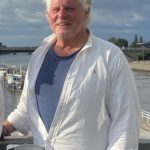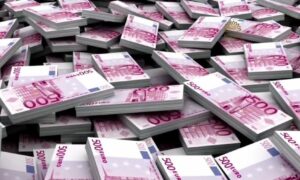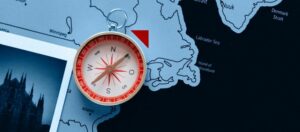(Editor’s note: This edition of the Eindhoven Business Briefing is part of Dispatches’ Tech Tuesdays series. Dispatches covers the innovation scene across Europe because so many of our highly skilled internationals work in tech.)
Eindhoven’s startup ecosystem was in the international spotlight Friday, 3 February, with a presentation to Shefali Razdan Duggal, the United States ambassador to the Netherlands. Duggal and her retinue of U.S. State Department personnel were at Building 27 on High Tech Campus Eindhoven for a visit organized by Brainport officials.
This was not just a perfunctory visit. Duggal came in uber-prepared for the event, with detailed background information on the people and organizations that propel this innovation center.
And we have to say it’s never been clearer to us how symbiotic our relationship with the U.S. really is, especially after Los Angeles-based private equity firm Oaktree Capital purchased the Campus back in 2021.
In a “six degrees of separation” moment, Duggal said she has a strong direct connection to Eindhoven through her friendship with Marsha Karsh, wife of Oaktree co-founder Bruce Karsh, with plans to meet the Karshes here in Eindhoven this summer.
Beyond the Oaktree acquisition, American capital, in part, fuels Eindhoven’s innovation ecosystem.
American expat founder Betsy Lindsey noted that her Aircision co-founder Luis Oliveira is currently in the U.S. raising funds. Lindsey and the other female tech founders agreed that European investors are risk averse while American investors are aggressive. “They’re completely different,” said Kathy Vredeveldt, CFO of inPhocal.
This was Ambassador Razdan Duggal’s first visit to North Brabant after being sworn in in October 2022.
Hilde de Vocht, High Tech Campus Eindhoven marketing and communications director and co-founder of Fe+male Tech Heroes, put together an extensive briefing, which included major contributors to the tech ecosystem.
The ambassador got a great overview of open innovation on High Tech Campus Eindhoven, along with insights on how HTXL and LUMO Labs build ventures focused on solving grand societal challenges. Jorn Smeets talked about PhotonDelta and its 1.1 billion euro initiative goal to create a vibrant ecosystem and invest in integrated photonics startups.
Ambassador Razdan Duggal is a women’s rights advocate and was very engaged with the panel of female founders de Vocht assembled for the gathering. Joining the panel were Betsy Lindsey (Aircision), Anitha (Senergetics), Kathy Vredeveldt (inPhocal) and Dzera Kaytati (Maaind).
• Aircision uses a proprietary laser system to link 5G telecommunication systems.
• inPhocal uses a proprietary design that focuses lasers in a device suitable for various applications from industrial printing to cutting computer chips.
• Senergetics uses photonic sensors to detect corrosion in industrial pipes.
• Maaind uses neuroadaptive AI technology to tailor consumer experiences.
Other participants included:
• John Bell, CEO of HighTechXL
John Bell told the American contingent how his venture builder creates deep-tech startups “on the edge of science.” Looking at societal needs, HighTechXL teams work in sectors from healthcare to energy transition. “We build 10 to 15 startups per year, which is not easy in the deep-tech space,” requiring time and capital, he said. Bell told the ambassador HighTechXL has connections to Austin and Singapore.
• Andy Lürling, founding partner at LUMO Labs
Andy Lürling introduced LUMO Labs and explained the venture builder/funds’ mission of investing in, then building, impact startups focused on social issues such as healthcare and education and technologies such as AI and the Internet of Things. LUMO Labs portfolio companies have 38 percent female founders, far higher than the global norm.
Razdan Duggal asked how the Netherlands is encouraging women to participate in STEM. De Vocht answered that math and science education begins in Dutch schools and continues in extracurricular activities. Also, the campus founded Fe+male Tech Heroes, recognizing women in tech and the men who support them.
Several of the female founders noted they have female interns. Lindsey credited her own success in Eindhoven to Expat Spouses Initiative, which connects the trailing spouses of employees at large Eindhoven companies with their own careers. “You need to have a global team to build global products. I think that for us is an extremely important initiative to continue to diversify,” she said.
The details of the briefing:
• High Tech Campus Eindhoven has 280 companies, including some of the largest American companies. The campus motto is: “Turning technology into business.”
• Hilde de Vocht emphasized that HTCE is all about open innovation and the companies working together. “That’s in the DNA of this region.”
Lightyear

Speaking of Americans … for years, we’ve thought about writing a post titled, “Why the American will always win.” One of the reasons is because American startups operate with a fail fast mentality. Something the Dutch might want to consider.
Take Lightyear.
We have to say we never got Lightyear. We weren’t the only ones. Jalopnik had a post back in 2021 lampooning Lightyear’s marketing claims of “independence from charging stations,” so you’re “free to roam the world.”
From the post:
Sure, you can get “up to 100 percent” of your mileage via solar energy if you only drive five miles a month. The phrase is meaningless. Hell, I can get “up to 100 percent” of my yearly mileage covered on one gallon of gas in my Pao if I only drive, oh, 40 miles per year.
This is from our EBB back in September 2021.
Lightyear has been around for five years and has produced a total of zero vehicles for sale to consumers. The capital needed to start a real car company is only increasing … one of the details that’s always puzzled us is: Why build a solar car that only wealthy countries in the sun-deprived northern hemisphere can afford when a solar-powered car is really only practical in perpetually sunny places such as California, the American West and South, the Middle East, Africa and tropical Asia?
The truth is, in the seven years Lightyear was trying to break into the car business, photovoltaic technology advanced to the point that established automakers can add solar if they so desire. And if they think it makes more sense than just doing what they do now and plugging in cars.
There is an upside to this, believe it or not.
There are lots of important lessons to draw from this folly, which burned through an aggregate 200 million euros in capital from regional development funds, Utrecht-based conglomerate SHV and Swedish supercar builder Koenigsegg.
• We’ve been to multiple tech events since the news about Lightyear broke and longtime entrepreneurs made us re-think our position. Their point is, Eindhoven gained a new generation of young startup veterans who’ve been through the wars. Not unlike the early days of Silicon Valley. In Europe, the specter of failure haunts entrepreneurs. We see the Lightyear debacle changing that, recognizing that founders brave enough to buck the odds deserve a second act.
• If an idea doesn’t make any sense, don’t keep throwing millions at it. Lightyear came out of Technical University of Eindhoven’s Solar Car team. The team earned global press by winning the World Solar Car Challenge every year. Proof of concept, right? Um, well the races are held in southern Africa and Australia. Where it’s sunny. Sheesh.
• If you’re going to compete in one of the most competitive industries on earth, you should have someone on your team over 30 who knows what they’re doing.
• If you’re going to crash and burn, just do it and get it over with. Don’t tell everyone you’ve got a “pre-order” for 10,000 cars worth 840 million euros on 17 January, then declare bankruptcy 10 days later, firing 600 people and stopping payments to your subsidiary company. The term “pre-order” alone should have been a big red flag to the media that this was smoke and mirrors.
• Innovation Origins and other media are reporting VDL or the Dutch government could bail out Lightyear. That would mean just pouring good money after bad. Capital that could be invested in startups and scale-ups with traction, producing actual products instead of a fantasy.
Our advice? Don’t do it. It’s going to take years for investors in this already risk-averse region to get the bad taste of Lightyear out of their mouths and reopen the checkbooks.
Just pull the plug.

Chip War
And now some good news: ASML is still the most important tech company in the world.
The bad news? No one still has heard of it.
Everyone is talking about the book “Chip War: The Fight for the Worlds’ Most Critical Technology” and Eindhoven-based ASML figures prominently in the narrative. In fact, the book is about how the national security and economic vitality of advanced nations are directly connected to the computer chip, and that all connects back to ASML and this town no one has ever heard of called Eindhoven.
The Verge has a great interview with “Chip War” author Chris Miller, a professor at Tufts University in Boston. In the interview, Miller explains how ASML – which the Verge journalist apparently has never heard of – is the only company in the world which makes the equipment necessary to make the most advanced computer chips and how adamant U.S. policymakers are that technology not fall into the hands of the Chinese.
More than that, it explains how ASML’s advanced lithography works, shooting laser beams into balls of tins traveling hundreds of miles per hour in a vacuum. To do all that, ASML engineers have developed the most powerful industrial lasers and flattest mirrors, and the post parses just how all this works. (Caution: It will make your head explode.)
We have insiders tell us all the time how China is this close to developing this technology. We’ll believe it when we see it.
You can’t get there from here
Bus strikes are scheduled for this week, but a recent trip has us swearing off using the travel option. Halfway into our trip to High Tech Campus Eindhoven on 3 February, a notification popped up on the app announcing our transfer at the Parktheatre stop was cancelled. That meant our only option was to go to Eindhoven station and grab a taxi, which was about 24 euros on top of the six for the bus. Not a big deal for us, but not everyone can use such an expensive option. Then, on our way home, the bus left the scheduled route for an unexplained detour to Valkenswaard. And the roughest ride we’ve ever experienced.
We were on our way back from an event with the US Ambassador, and at that meeting, we debated with others in the tech ecosystem what Eindhoven’s options are as it adds a projected 70,000 residents over the next five years. We lived in Izmir back in the 2000s, where they built a subway to cope with the city’s dramatic growth. Turkey certainly doesn’t have a tax base comparable to the Netherlands, yet Eindhoven and other Dutch cities are still relying on buses.
Economic growth is a three-legged stool – housing, jobs and transportation. Right now, Eindhoven only has one of the three legs.
Co-CEO of Dispatches Europe. A former military reporter, I'm a serial expat who has lived in France, Turkey, Germany and the Netherlands.















